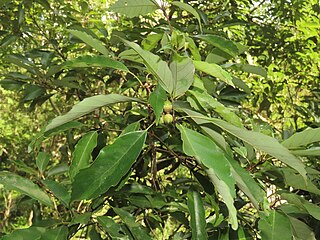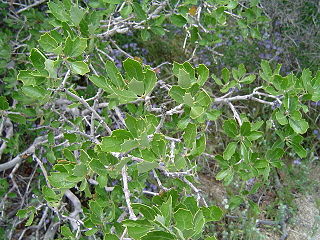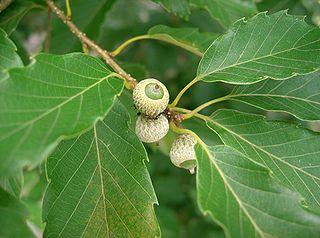
Quercus montana, the chestnut oak, is a species of oak in the white oak group, Quercus sect. Quercus. It is native to the eastern United States, where it is one of the most important ridgetop trees from southern Maine southwest to central Mississippi, with an outlying northwestern population in southern Michigan. It is also sometimes called rock oak because of its presence in montane and other rocky habitats.

Quercus stellata, the post oak or iron oak, is a North American species of oak in the white oak section. It is a slow-growing oak that lives in dry areas on the edges of fields, tops of ridges, and also grows in poor soils, and is resistant to rot, fire, and drought. Interbreeding occurs among white oaks, thus many hybrid species combinations occur. It is identifiable by the rounded cross-like shape formed by the leaf lobes and hairy underside of the leaves.

Quercus trojana, the Macedonian oak is an oak in the turkey oak section (Quercus sect. Cerris).

Quercus glauca, commonly called ring-cupped oak or Japanese blue oak, is a tree in the beech family (Fagaceae). It is native to eastern and southern Asia, where it is found in Afghanistan, Bhutan, China, northern and eastern India, southern Japan, Kashmir, Korea, Myanmar, Nepal, and Vietnam. It is placed in subgenus Cerris, section Cyclobalanopsis.

Quercus berberidifolia, the California scrub oak, is a small evergreen or semi-evergreen shrubby oak in the white oak section of Quercus. It is a native of the scrubby hills of California, and is a common member of chaparral ecosystems.

Quercus imbricaria, the shingle oak, is a deciduous tree in the red oak group of oaks. It is native primarily to the Midwestern and Upper South regions of North America.

Quercus dentata, also called Japanese emperor oak, daimyo oak, or Korean oak, is a species of oak native to East Asia. The name of the tree is often translated as "sweet oak" in English to distinguish it from Western varieties. It is placed in section Quercus.

Quercus variabilis, the Chinese cork oak, is a species of oak in the section Quercus sect. Cerris, native to a wide area of eastern Asia in southern, central, and eastern China, Taiwan, Japan, and Korea.

Quercus myrsinifolia is an Asian species of tree in the beech family Fagaceae. It has several common names, including bamboo-leaf oak, Chinese evergreen oak, and Chinese ring-cupped oak. Its Chinese name is 小叶青冈; pinyin: xiǎo yè qīng gāng, which means little leaf ring-cupped oak, in Japan it is called white oak and in Korea it is known as gasinamu (가시나무). It is native to east central and southeast China, Japan, Korea, Laos, northern Thailand, and Vietnam. It is placed in subgenus Cerris, section Cyclobalanopsis.

Quercus pagoda, the cherrybark oak, is one of the most highly valued red oaks in the southern United States. It is larger and better formed than southern red oak and commonly grows on more moist sites. Its strong wood and straight form make it an excellent timber tree. Many wildlife species use its acorns as food, and cherrybark oak makes a fine shade tree. Cherrybark oak was formerly considered to be a subspecies of southern red oak, Quercus falcata, subsp pagodifolia.

Quercus havardii is a deciduous, low-growing, thicket-forming shrub that occupies some two million to three million hectares in the southern Great Plains of North America. Clones may reach hundreds to thousands of years old, although aboveground stems typically live only 11 to 15 years. Shinnery oak stems are usually 1 to 2 metres tall and codominate the plant community with mid- and tall-grasses, which are usually taller than the oaks.

Quercus cornelius-mulleri is a North American species of oak known by the common name Muller oak, or Muller's oak. It was described to science in 1981 when it was segregated from the Quercus dumosa complex and found to warrant species status of its own. It was named after ecologist Cornelius Herman Muller. It is native to southern California and Baja California, where it grows in chaparral, oak woodlands, and other habitat in foothills and mountains. It can most easily be observed in Joshua Tree National Park and in the woodlands along the western margins of the Colorado Desert in San Diego County, California.

Quercus john-tuckeri is a North American species of oak known by the common name Tucker oak, or Tucker's oak. It is endemic to California, where it grows in the chaparral and oak woodlands of mountain slopes in the western Transverse Ranges, the southernmost Central Coast Ranges, and the margins of the Mojave Desert. The species is named after John M. Tucker, professor of botany (1947–1986) at the University of California at Davis, specialist in Quercus.

Quercus geminata, commonly called sand live oak, is an evergreen oak tree native to the coastal regions of the subtropical southeastern United States, along the Atlantic Coast from southern Florida northward to southeastern Virginia and along the Gulf Coast westward to southern Mississippi, on seacoast dunes and on white sands in evergreen oak scrubs.

Quercus serrata, the jolcham oak, is an East Asian species of tree in the beech family. It is native to China, Taiwan, Japan, and Korea.

Quercus gilva, the red-bark oak, is a species of tree in the beech family Fagaceae. It has been found in Japan, Korea, and southeastern China. It is placed in subgenus Cerris, section Cyclobalanopsis.
Salix annulifera is a small shrub from the genus of the willow (Salix) with up to 8 centimeter long leaf blades. The natural range of the species is in China.
Salix chienii is a large shrub or small tree in the willow genus Salix with initially light green and tomentose hairy and later reddish brown and balding branches. The leaf blades have lengths of 2 to 3.5 sometimes 5.5 centimeters. The natural range of the species is in China.
Salix crenata is a cushion-shaped growing shrub from the genus of willow (Salix) with about 8 millimeter long leaf blades. The natural range of the species is in China.
Salix delavayana is a shrub or small tree from the genus willow (Salix) with mostly 3 to 8 centimeters long leaf blades. The natural range of the species is in the south of China and in Tibet.


















